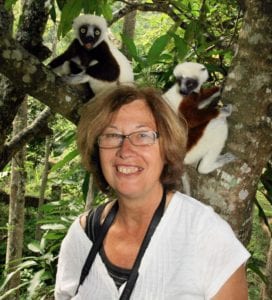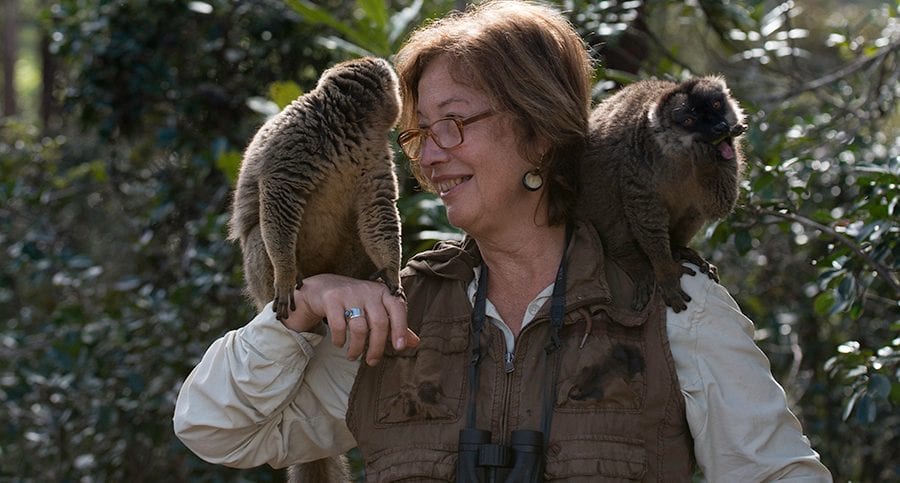Stony Brook University Distinguished Professor Patricia Wright wants you to visit Madagascar, virtually for now and in person in the future. Wright, an award-winning scientist who has spent over 30 years studying the lemurs of the island nation of Madagascar, has been encouraging virtual ecotourism to the island nation, which has been struggling economically amid a pandemic that halted tourism. Wright recently raised money to support continuing operations for Centre ValBio, a research station she built in a national park she helped create. She has also helped secure money to create the nation’s first canopy walkway. The award-winning professor discussed COVID-19, conservation and science in Madagascar.
TBR: How has Covid affected Madagascar?
 Wright: I flew back in January just after New Year’s. The Madagascar I saw was a lot different from New York. They have been able to stave off Covid by not allowing people into the country. It’s an island nation. There’s only one international airport. It was in some ways, a little bit better than in New York because there was less Covid. However, economically, it was a disaster because much of the gross national product for Madagascar is tourism and there has been absolutely no tourists there, and no researchers, either.
Wright: I flew back in January just after New Year’s. The Madagascar I saw was a lot different from New York. They have been able to stave off Covid by not allowing people into the country. It’s an island nation. There’s only one international airport. It was in some ways, a little bit better than in New York because there was less Covid. However, economically, it was a disaster because much of the gross national product for Madagascar is tourism and there has been absolutely no tourists there, and no researchers, either.
TBR: Has the government provided some support to bridge the gap?
Wright: It’s a real problem, because it’s the third poorest country in the world. The government doesn’t have a lot of funding. We’ve been asking for funding from the United Nations, from the World Health Organization, from the international agencies and they’ve been able to give some stop gap funding.
TBR: Does this crisis become worse with each passing week?
Wright: This is what I worry about because families were telling me when I was in Madagascar that they don’t have money to buy the seeds to plant their crops. That means that it’s not only right now that they don’t have enough money, but if they don’t plant the rice, they’re not going to have enough rice to eat. It’s reaching a crisis. Stony Brook has really pitched in … We have virtual wildlife tours, where people can go to Madagascar and our tourist guides will take you to Ranomafana. That’s adding income. People are taking their families to Madagascar by just doing zoom.
TBR: Does it look like tourists will return to Madagascar soon?
Wright: We’re hoping that that will occur in June or July of this year. That’s what the hope is, that this will start. The international airport right now is closed. That’s a good thing because that means that there’s not as much Covid coming in … When enough people get vaccinated, you’ll probably have to show your vaccination card if you want to get on a plane.
TBR: Are people booking trips?
Wright: I have a ticket to go at the end of May. Air France and Ethiopian Airlines are booking tickets for May, June and July. There’s hope.
TBR: You mentioned the virtual tours that people are taking. How many people are taking those tours?
Wright: A couple of hundred a week, and particularly because we’re also tapping into schools. A teacher can bring a class to Madagascar … Families can have a family reunion going to Madagascar all together. It’s interactive.
TBR: Are people seeing the same things they would see if they were on site?
Wright: They have some really great footage. They can get much closer to lemurs than if you were underneath them looking up in real life.
TBR: Do you hope people will follow up with an in person visit?
Wright: I’m hoping we’ll get a big increase in tourism once everything opens up
TBR: What about conservation?
Wright: It’s really difficult because people think that because the nation is shut down from the outside world, they can just go in and hunt. They can go back into protected areas because there’s not tourists there. There’s a real threat. We’ve been able to continue our programs in education and health and reforestation.
TBR: Are you concerned that some of these species might become extinct?
Wright: I really worry about that. There are some species of lemurs where there’s only 50 left. … We have 113 species of lemurs. They are in every part of Madagascar. It’s hard to protect them all, each one is so individually different. Lemurs have been evolving for 55 million, 60 million years. They’re only found on Madagascar. If we lose them, we really lose a part of our primate history that is very precious.
TBR: Is there any thought about capturing them and protecting them in an enclosed space?
Wright: We have thought about that. There has to be a long term program, though. If you bring that many animals into captivity, you have to be sure you have the funding to keep them fed and well protected. We have been thinking about that. We’ve been doing some translocations, where we take them from a place where they’re really threatened and they’re eating crops and farmers don’t like that. We take them out of that very dangerous situation and bring them into a protected area.
TBR: Are there funders that recognize this is a time where they can do the most good?
Wright: We do have some foundations that are stepping up, but we need more to step up … I just received a grant from the Leakey Foundation, which is out of San Francisco, and they just gave us money to keep the lights on for another three months. We are working hard to keep going.
TBR: How can people help?
Wright: I’ve already mentioned virtual tours [which cost about] $30 a person. For donating, we have a donation button at Centre ValBio. This is through Stony Brook and Stony Brook is very good about making sure the money goes straight to Centre ValBio, which is the name of the research station.
TBR: What about the science side?
Wright: I just got off a Zoom call with the sifaka guys … With the Covid year, we have a beautiful database, now we’re able to mine that, which consists of the plants and animals that are in Ranomafana. We’re making a relational database [that has over] 35 years of data that we’ve been taking from all over the region. It’s one of the few long term databases that there are in the tropics and we’re very proud of that.
TBR: Will the public be able to access some of that data?
Wright: Yes, we’re not at that point yet, but that what’s what we’re hoping for … We just heard news that we’re going to have a canopy walkway, which we have been wanting to put into Ranomafana National Park for over a decade and the funding has just been found. And so, we are going over to Ranomafana in May/ June with a designer to put in that canopy, so we’ll be ready for the tourists when they come, so they can go up in the canopy and see the lemurs eye to eye, to be able to see those chameleons and birds and everything in a new way.
TBR: Who provided the funding?
Wright: It’s called Mission Green and the organization is raising money just for canopy walkways, there will be 20 canopy walkways. This will be the only one in Madagascar.
TBR: As far as the sifaka call you mentioned earlier, is there any news?
Wright: So far, we know that all the babies from last year have survived. We’re kind of at that stage right now. That’s very exciting. The babies will be born in May and June.
TBR: What did you notice that was different in the Covid world of Madagascar?







